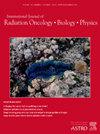A Double-Blinded Placebo-Controlled Biomarker Stratified Randomized Trial of Apalutamide (APA) and Radiotherapy for Recurrent Prostate Cancer (NRG GU006, BALANCE trial)
IF 6.5
1区 医学
Q1 ONCOLOGY
International Journal of Radiation Oncology Biology Physics
Pub Date : 2025-10-14
DOI:10.1016/j.ijrobp.2025.08.028
引用次数: 0
Abstract
Purpose/Objective(s)
Currently there are no prospectively validated predictive biomarkers to guide use of hormonal therapy in prostate cancer. NRG GU006, a phase II biomarker stratified randomized trial of patients receiving salvage radiotherapy (SRT) with or without APA, was designed with the hypothesis that transcriptionally defined molecular subtypes would differentially benefit from APA.
Materials/Methods
Patients were enrolled between 4/2018-2/2020 and were required to be status post-radical prostatectomy with a PSA 0.1-1.0 ng/mL without evidence of nodal or distant metastasis and randomized to SRT with placebo or APA 240 mg daily for 6 months. Patients were stratified by PAM50 molecular subtype (luminal B vs non-luminal-B). The primary endpoint was biochemical progression-free survival (bPFS), defined as first occurrence of biochemical, local, regional, distant recurrence, or death from any cause. Key secondary endpoints reported are metastasis-free survival (MFS) and adverse events. The design and analysis involved first testing efficacy within the luminal B subtype (hypothesized to show greater benefit), followed by evaluation of the non-luminal-B group. If the lower limit of the 80% confidence interval (CI) for the hazard ratio (HR [APA/placebo]) in the latter group was >0.77, lack of efficacy in this subgroup would be declared.
Results
A total of 295 eligible patients were enrolled with a median follow-up of 5.0 years. Arms were well balanced, with a median age of 65 years, 50% with positive surgical margins, 51% with pathologic T3 disease, 86% with entry PSA of <0.5 ng/mL; 19% were grade group 4-5, and 43% were luminal B. In luminal B patients APA significantly improved bPFS (HR 0.45, 80%CI 0.29-0.68, one-sided p=0.0062), with 5-year estimated bPFS of 72.4% vs 53.9% in the APA and placebo arms, respectively. In contrast, non-luminal B patients did not demonstrate improvement in bPFS (HR 0.95, 80%CI 0.65-1.41, p=0.44), with 5-year estimated bPFS of 70.2% vs 71.1%, although the lower CI limit was <0.77. MFS was also improved with APA in luminal B patients, HR 0.27, 95%CI 0.07-0.95, p=0.029; 5-year estimates of 94.7% vs 81.8%, but not in non-luminal B patients, HR 1.06, 95%CI 0.41-2.78, p=0.90; 5-year estimates of 89.9% vs 89.3%. In the APA vs placebo arm (regardless of attribution), grade 3+ gastrointestinal toxicity occurred in 5.7% vs 2.6%, and genitourinary toxicity in 3.5% vs 4.5%, respectively. In the APA arm, grade 3+ rash occurred in 5.0% of patients and breast pain in 0.7%.
Conclusion
Patients with transcriptionally defined luminal B tumors derived improvement in clinically meaningful endpoints from the addition of APA to SRT. PAM50 represents the first prospectively validated predictive biomarker for hormone therapy in prostate cancer in a randomized trial.
阿帕鲁胺(APA)与放疗治疗复发性前列腺癌的双盲安慰剂对照生物标志物分层随机试验(NRG GU006, BALANCE试验)
目的/目的:目前还没有前瞻性验证的预测性生物标志物来指导前列腺癌激素治疗的使用。NRG GU006是一项II期生物标志物分层随机试验,研究对象是接受补救性放疗(SRT)的患者,有或没有APA,该试验的设计假设是转录定义的分子亚型将从APA中获益。材料/方法患者在2018年4月至2020年2月期间入组,要求处于根治性前列腺切除术后状态,PSA为0.1-1.0 ng/mL,无淋巴结或远处转移证据,随机分为安慰剂组或APA 240 mg /天的SRT组,持续6个月。根据PAM50分子亚型(luminal -B vs non-luminal-B)对患者进行分层。主要终点是生化无进展生存期(bPFS),定义为首次发生生化、局部、区域、远处复发或任何原因死亡。报告的主要次要终点是无转移生存期(MFS)和不良事件。设计和分析包括首先测试luminal-B亚型的疗效(假设显示更大的益处),然后评估非lumininal -B组。如果后一组的风险比(HR [APA/安慰剂])的80%置信区间(CI)下限为>;0.77,则宣布该亚组缺乏疗效。结果共纳入295例符合条件的患者,中位随访时间为5.0年。双臂平衡良好,中位年龄65岁,50%手术切缘阳性,51%病理性T3疾病,86%进入PSA为0.5 ng/mL;4-5级组19%,luminal B组43%。在luminal B组患者中,APA显著改善了bPFS (HR 0.45, 80%CI 0.29-0.68,单侧p=0.0062), 5年估计bPFS分别为72.4%和53.9%。相比之下,非腔内B型患者的bPFS没有改善(HR 0.95, 80%CI 0.65-1.41, p=0.44), 5年估计bPFS为70.2% vs 71.1%,尽管CI下限为0.77。APA也改善了luminal B患者的MFS, HR为0.27,95%CI为0.07 ~ 0.95,p=0.029;5年估计为94.7% vs 81.8%,但在非腔内B型患者中没有,HR 1.06, 95%CI 0.41-2.78, p=0.90;5年估计为89.9% vs 89.3%。在APA组和安慰剂组中(不论原因),3+级胃肠道毒性分别为5.7%和2.6%,泌尿生殖系统毒性分别为3.5%和4.5%。在APA组中,5.0%的患者出现3+级皮疹,0.7%的患者出现乳房疼痛。结论经转录定义的腔内B肿瘤患者在SRT中加入APA后在临床有意义的终点得到改善。在一项随机试验中,PAM50代表了前列腺癌激素治疗的第一个前瞻性验证的预测性生物标志物。
本文章由计算机程序翻译,如有差异,请以英文原文为准。
求助全文
约1分钟内获得全文
求助全文
来源期刊
CiteScore
11.00
自引率
7.10%
发文量
2538
审稿时长
6.6 weeks
期刊介绍:
International Journal of Radiation Oncology • Biology • Physics (IJROBP), known in the field as the Red Journal, publishes original laboratory and clinical investigations related to radiation oncology, radiation biology, medical physics, and both education and health policy as it relates to the field.
This journal has a particular interest in original contributions of the following types: prospective clinical trials, outcomes research, and large database interrogation. In addition, it seeks reports of high-impact innovations in single or combined modality treatment, tumor sensitization, normal tissue protection (including both precision avoidance and pharmacologic means), brachytherapy, particle irradiation, and cancer imaging. Technical advances related to dosimetry and conformal radiation treatment planning are of interest, as are basic science studies investigating tumor physiology and the molecular biology underlying cancer and normal tissue radiation response.

 求助内容:
求助内容: 应助结果提醒方式:
应助结果提醒方式:


